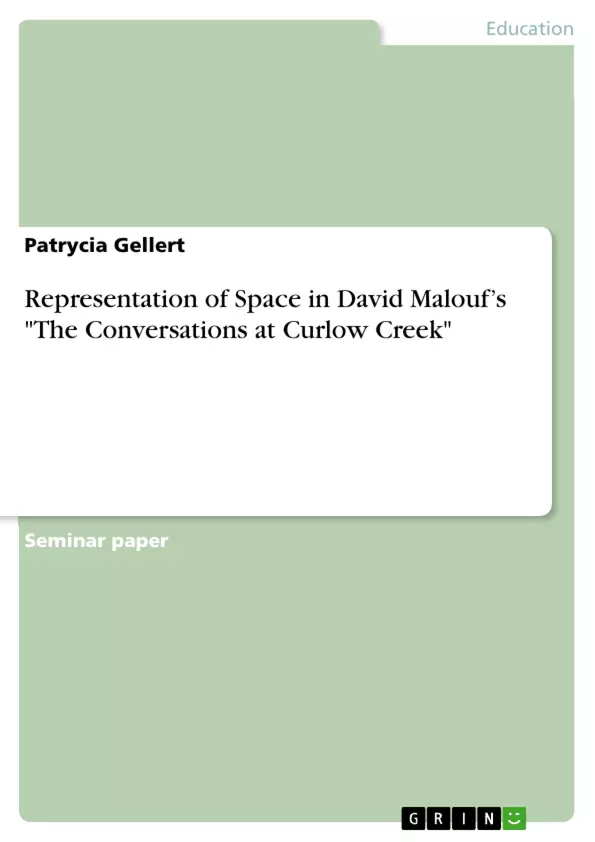Scholars of Antipodean culture emphasise the power of nature on both personal and national matters. With respect to Australia, Krahn (2000) points to the impact that space has on self-conception, arguing that notions of space/ place have been central in the cultural self-definition of settler colonies like Australia, since difference in place is the most visible marker distinguishing the colony from the imperial motherland. In Australian literary discourses, place is very much tied up with landscape, presumably as difference in landscape foregrounds the distinguishing difference of place. Landscape is thus used to emphasise the distinctiveness of Australia, from earliest colonial writings to the present day discourses of nationalism, literature and tourism.
Against these backgrounds and with the objective to corroborate theoretical foundations on the representation of Australia in (pre-)colonial (literary) discourse, The Conversations at Curlow Creek by David Malouf will be analysed and examined with regard to the spatial representation of Australia as contrasted with Ireland, juxtaposing the portrayals of both countries by highlighting their major disparities adverted to in the novel. In the course of this, dichotomies as one identifiable literary device, which serves as an amplification of the images the author aims at getting across, will be pointed to.
Prior to that, the concept of space will be elaborated on, providing a definition and conceptual differentiation within the scope of narratology. Furthermore, the characteristic representation of Australia in colonial discourse will be expounded, particularly relating to the aspect of landscape. Finally, a conclusion based on the results of the text analysis will be provided, substantiating the underlying theoretical foundations.
Inhaltsverzeichnis (Table of Contents)
- Introduction
- Theoretical framework
- The concept of space
- Representation of Australia in settler-colonial discourse/ literary works
- Spatial representation of Australia as opposed to Ireland in Malouf's The Conversations at Curlow Creek
- Representation of Australia
- Representation of Ireland
- Contrasting juxtaposition of Australia and Ireland
- Conclusion
Zielsetzung und Themenschwerpunkte (Objectives and Key Themes)
This work aims to analyze David Malouf's The Conversations at Curlow Creek in the context of postcolonial studies, focusing on the spatial representation of Australia and Ireland in the novel. It examines how the representation of space in the novel contributes to the broader discourse of settler-colonialism and national identity in Australia.
- The concept of space in narratology and its different levels.
- Representation of Australia in settler-colonial discourse and literature.
- Spatial representation of Australia and Ireland in The Conversations at Curlow Creek.
- The contrasting juxtaposition of Australia and Ireland in the novel.
- Dichotomies as a literary device in representing the contrasting spaces.
Zusammenfassung der Kapitel (Chapter Summaries)
- Introduction: Introduces the research topic and its significance in the field of postcolonial studies. Discusses the importance of space and its representation in Australian settler literature, highlighting the influence of landscape on national and individual identity. Sets the stage for the analysis of The Conversations at Curlow Creek.
- Theoretical framework: Explores the concept of space in narratology, defining its role and different levels of representation. Elaborates on the representation of Australia in colonial discourse, particularly in relation to landscape and its significance in shaping national identity.
- Spatial representation of Australia as opposed to Ireland in Malouf's The Conversations at Curlow Creek: Analyzes the novel's portrayal of Australia and Ireland, highlighting the contrasting representations of space and their implications. Examines how the novel uses dichotomies as a literary device to amplify the differences between the two countries.
Schlüsselwörter (Keywords)
This work focuses on the representation of space in David Malouf's The Conversations at Curlow Creek within the context of postcolonial studies. Key themes include the concept of space in narratology, representation of Australia in settler-colonial discourse, spatial representation of Australia and Ireland in the novel, and the contrasting juxtaposition of both countries.
- Citation du texte
- Patrycia Gellert (Auteur), 2018, Representation of Space in David Malouf’s "The Conversations at Curlow Creek", Munich, GRIN Verlag, https://www.grin.com/document/428959



